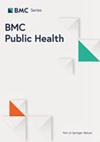尼日利亚东北部既往感染过 COVID-19 的人群罹患糖尿病前期和糖尿病的风险升高
IF 3.5
2区 医学
Q1 PUBLIC, ENVIRONMENTAL & OCCUPATIONAL HEALTH
引用次数: 0
摘要
据报道,在美国、欧洲和亚洲,COVID-19 后糖尿病(DM)风险增加。在非洲,与 COVID 相关的 DM 的负担尚未得到描述,而在非洲,DM 的总体风险正在迅速增加。我们的目的是比较有 COVID-19 感染史的尼日利亚人与未感染 COVID-19 的尼日利亚人中前期 DM 和 DM 的发病率。我们对 256 名既往有 COVID-19 病史但没有 DM 前病史的人和 256 名没有 COVID-19 病史或 DM 前病史的人进行了回顾性队列研究。参与者被分为DM前期(空腹毛细血管葡萄糖100-125 mg/dL)或DM(空腹毛细血管葡萄糖≥126 mg/dL)。我们采用单变量和多变量逻辑回归来确定主要预测因素,并调整与高血糖风险因素相关的混杂因素。此外,我们还采用多项式逻辑回归分析了 COVID-19 病史与糖尿病状态之间的关系,并对正常、糖尿病前期和糖尿病血糖水平进行了区分。所有模型都对年龄、性别、高血压、体力活动、中心脂肪率和糖尿病家族史进行了调整。与对照组相比,有 COVID-19 病史者的中位年龄相似(38 岁对 40 岁,P = 0.84),男性比例较高(63% 对 49%),中心性肥胖(男性腰围:臀围比≥ 0.90,女性 WHR ≥ 0.85)发生率较低(48% 对 56.3%,P = 0.06)。在有 COVID-19 病史的 256 人中,44 人(17%)需要住院治疗。COVID-19 诊断与血糖评估之间的中位时间间隔为 19 个月(IQR:14 至 24 个月)。COVID-19后组中糖尿病前期发病率为27%,对照组为4%,而COVID-19后组中糖尿病发病率为7%,对照组为2%。经多变量调整后,与对照组相比,有COVID-19病史者发生DM前期的几率要高8.12(95% 置信区间(CI):3.98,16.58;P < 0.001),发生DM的几率要高3.97(95% CI:1.16,13.63)。在调整后的多项式逻辑回归分析中,与没有 COVID-19 的人相比,有 COVID-19 病史的人患糖尿病前期(RRR = 7.55,95% CI:3.76-15.17)和糖尿病(RRR = 3.44,95% CI:1.01-11.71)的风险明显升高。研究发现,曾患 COVID-19 是尼日利亚糖尿病前期和糖尿病流行的一个风险因素。应考虑对有 COVID-19 病史的人进行更密集的糖尿病筛查。本文章由计算机程序翻译,如有差异,请以英文原文为准。
Elevated risk of pre-diabetes and diabetes in people with past history of COVID-19 in northeastern Nigeria
An increased risk of diabetes mellitus (DM) after COVID-19 has been reported in the United States, Europe, and Asia. The burden of COVID-related DM has yet to be described in Africa, where the overall risk of DM has been increasing rapidly. Our objective was to compare the prevalence of pre-DM and DM in Nigerian individuals with a history of COVID-19 to individuals without known COVID-19 infection. We undertook a retrospective cohort study with 256 individuals with a past medical history of COVID-19 with no history of pre-DM or DM and 256 individuals without a history of COVID-19 or pre-DM/DM. Participants were categorized as pre-DM (fasting capillary glucose 100–125 mg/dL) or DM (fasting capillary glucose ≥ 126 mg/dL). We employed univariate and multivariable logistic regression to identify key predictors and adjust for confounders related to hyperglycaemia risk factors. Additionally, we used multinomial logistic regression to analyze the relationship between COVID-19 history and diabetes status, distinguishing between normal, pre-diabetic, and diabetic glucose levels. All models were adjusted for age, gender, hypertension, physical activity, central adiposity, and family history of DM. Compared to the control group, those with a history of COVID-19 had a similar median age (38 vs. 40 years, p = 0.84), had a higher proportion of men (63% vs. 49%), and had a lower prevalence of central adiposity (waist: hip ratio ≥ 0.90 for males and WHR ≥ 0.85 for females) (48% vs. 56.3%, p = 0.06). Of the 256 with a history of COVID-19, 44 (17%) required in-patient care. The median (interquartile range) time interval between COVID-19 diagnosis and the glycaemic assessment was 19 (IQR: 14, 24) months. Pre-DM prevalence was 27% in the post-COVID-19 group and 4% in the control group, whereas the prevalence of DM was 7% in the post-COVID-19 group and 2% in the control group. After multivariable adjustment, the odds of pre-DM were 8.12 (95% confidence interval (CI): 3.98, 16.58; p < 0.001) higher, and the odds of DM were 3.97 (95% CI: 1.16, 13.63) higher in those with a history of COVID-19 compared to controls. In the adjusted multinomial logistic regression analysis, individuals with a history of COVID-19 exhibited significantly elevated risks for pre-diabetes (RRR = 7.55, 95% CI: 3.76–15.17) and diabetes (RRR = 3.44, 95% CI: 1.01–11.71) compared to those without COVID-19. Previous COVID-19 was found to be a risk factor for prevalent pre-diabetes and diabetes mellitus in Nigeria. More intensive screening for DM in those with a history of COVID-19 should be considered.
求助全文
通过发布文献求助,成功后即可免费获取论文全文。
去求助
来源期刊

BMC Public Health
医学-公共卫生、环境卫生与职业卫生
CiteScore
6.50
自引率
4.40%
发文量
2108
审稿时长
1 months
期刊介绍:
BMC Public Health is an open access, peer-reviewed journal that considers articles on the epidemiology of disease and the understanding of all aspects of public health. The journal has a special focus on the social determinants of health, the environmental, behavioral, and occupational correlates of health and disease, and the impact of health policies, practices and interventions on the community.
 求助内容:
求助内容: 应助结果提醒方式:
应助结果提醒方式:


